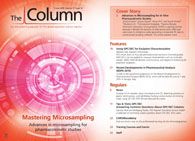Microdestructive Capillary Electrophoresis Analysis of Ink Samples
A novel microdestructive capillary electrophoresis (CE) method for the analysis of blue pen ink strokes has been published. The analysis of pen inks can be challenging because ink compositions are usually under patent, the samples are small, and inks can degrade over time.
A novel microdestructive capillary electrophoresis (CE) method for the analysis of blue pen ink strokes has been published in the Journal of Chromatography A.1 The analysis of pen inks can be challenging because ink compositions are usually under patent, the samples are small, and inks can degrade over time.
CE has previously given promising results when applied to the analysis of questionable documents, according to coauthor Matías Calcerrada. He told The Column: “We believe that CE could be an efficient analytical technique for casework involving questioned documents, due to advantages such as its minimal sample consumption and ability to detect and quantify different analytes found in ink formulations.”
The team developed a microdestructive sample treatment method using a scalpel to scratch 0.3 mg of an ink stroke from paper, prior to analysis using CE with a DAD detector. Samples of ink from 34 blue pens from different technologies (ballpoint, rollerball, marker) with different composition (gel, water-based, oil-based) were analyzed to discriminate between different technologies and inks. Calcerrada said: “We believe that the results published demonstrate that the method could be applied in forensic casework after applying other non-destructive methodologies, which are always recommended before destroying the sample.” - B.D.
Reference
1. Matías Calcerrada, Journal of Chromatography A1400, 140–148 (2015).

Determining Enhanced Sensitivity to Odors due to Anxiety-Associated Chemosignals with GC
May 8th 2025Based on their hypothesis that smelling anxiety chemosignals can, like visual anxiety induction, lead to an increase in odor sensitivity, a joint study between the University of Erlangen-Nuremberg (Erlangen, Germany) and the Fraunhofer Institute for Process Engineering and Packaging (Freising, Germany) combined behavioral experiments, odor profile analysis by a trained panel, and instrumental analysis of odorants (gas chromatography-olfactometry) and volatiles (gas chromatography-mass spectrometry).
Investigating 3D-Printable Stationary Phases in Liquid Chromatography
May 7th 20253D printing technology has potential in chromatography, but a major challenge is developing materials with both high porosity and robust mechanical properties. Recently, scientists compared the separation performances of eight different 3D printable stationary phases.
Detecting Hyper-Fast Chromatographic Peaks Using Ion Mobility Spectrometry
May 6th 2025Ion mobility spectrometers can detect trace compounds quickly, though they can face various issues with detecting certain peaks. University of Hannover scientists created a new system for resolving hyper-fast gas chromatography (GC) peaks.

.png&w=3840&q=75)

.png&w=3840&q=75)



.png&w=3840&q=75)



.png&w=3840&q=75)







